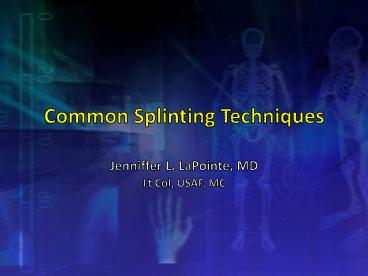Common Splinting Techniques - PowerPoint PPT Presentation
1 / 26
Title:
Common Splinting Techniques
Description:
Reduce orthopedic referral rate (experienced FP in orthopedics only 16-25 ... Distal Tibia / Fibula Fractures. Non Displaced Ankle Fracture. Key Points ... – PowerPoint PPT presentation
Number of Views:281
Avg rating:3.0/5.0
Title: Common Splinting Techniques
1
Common Splinting Techniques
- Jenniffer L. LaPointe, MD
- Lt Col, USAF, MC
2
Why splint/cast?
- Acute musculoskeletal injuries common in primary
care (especially in military!) - Continuity
- Reduce orthopedic referral rate (experienced FP
in orthopedics only 16-25 fracture referral rate
excluding hip/face fractures) - Studies concluding that most FP managed fractures
heal well and most complications can be avoided
with appropriate selection of which fractures to
manage - RVU density! Orthopedics pays
3
RVU density
- Example Healthy 5 year old female comes in
after FOOSH injury with nondisplaced torus fx of
distal radius on x-ray, normal exam except for
tenderness over distal radius - On initial visit 99213 visit (0.67 RVUs) with
CPT 29125, application of short arm splint (0.59
RVUs) with total RVUs on initial visit 1.26
RVUs - THEN patient f/u done 3-4 days later after
swelling has decreased and 99213 coded (0.67
RVUs) and CPT 25500, closed treatment of radial
shaft fracture without manipulation (2.51 RVUs)
with total of 3.18 RVUs - Follow up in 3 weeks with removal of cast, 99213
(0.67 RVUs) - Total of 5.11 RVUs for treatment and orthopedic
referral avoided - 2008 RVU values (increased 0.82 RVUs for CPT
25500 vs 2006 values)
4
Pre and Post Splint Checks
- F Function
- A Arterial Pulse
- C Capillary Refill
- T Temperature (Skin)
- S - Sensation
5
Thumb Spica 3
- Indications for thumb spica
- Navicular / Scaphoid Fractures
- Thumb Dislocations/Proximal thumb fractures
- Ulnar Collateral Ligament Sprains
- Tendonitis
- Key Points
- 3 fingerbreadths from antecubital fossa
- Tip of thumb spiral
- 2 figure of 8 wraps with wrap
6
When do I need an orthopedist?
- Indications for orthopedic referral
- Scaphoid Fractures any displacement or
angulation, non-union or avascular necrosis
develops after conservative treatment, or
scapholunate dissociation (gt3mm distance) - Proximal Thumb Fractures any intraarticular
fracture, comminution, any fracture where
adequate closed reduction cannot be maintained - Ulnar Collateral Ligament Injuries avulsion
fracture with more than 2 mm displacement,
fractures with more than 20 articular surface
involvement, complete rupture of UCL (tested at
30 degrees flexion of MCP after radiographs are
obtained)
7
Volar Splint 3 or 4
- Indications
- Wrist Sprains
- Carpal Tunnel Syndrome/Night Splints
- Lacerations
- Simple/nondisplaced radius or ulna fractures
- Key Points
- palmar crease to 3 fingerbreadths from
antecubital fossa - 1 fold _at_ angle of palmar crease
8
(No Transcript)
9
(No Transcript)
10
Teardrop Splint 4-5
- Indications
- 2nd 3rd Metacarpal Fractures
- Flexor Tendon Repairs or Extensor Tendon
- Crushing Injuries
- Lacerations
- Key Points
- Tip of 3rd finger to 3 fingerbreadths from
antecubital fossa - Cut 2 ½ hole for thumb tape edges
- Flex metacarpals 45 (70-90 if distal fracture)
and wrist 20-30 extension
11
Boxer Splint 4-5
- Indications
- 5th Metacarpal Fractures
- 4th Metacarpal Fractures
- Key Points
- Tip of 5th finger to 3 fingerbreadths from
antecubital fossa - Pad b/t 4th and 5th fingers
- Ulnar gutter
- Mold to position, MCP at 70-90 flexion to
maintain positioning in distal fractures
12
(No Transcript)
13
(No Transcript)
14
2 WEEKS LATER
15
Reverse Sugar Tong 3- 4
- Indications
- Colles Fracture
- Forearm Fractures
- Key Points
- Measure from behind the elbow up both sides of
the arm to the tip of the fingers - Cut at mid-point leaving 1/2 and slide over the
hand - Overlap the ends at the elbow, wrap from the hand
down
16
(No Transcript)
17
(No Transcript)
18
Figure 8 Splint
- Indications
- Mid-shaft clavicular fractures (Proximal/distal
clavicular fractures often treated with
sling/swath /- operative treatment) - Key Points
- Measure so position of attention attained
- Advantage of leaving elbow and hand free BUT
requires assistance to put on - Counsel patient bony deformity possible
- Orthopedic referral rarely indicated for
mid-clavicular fractures
19
Posterior Ankle 4 - 5
- Indications
- Distal Tib / Fib Fractures
- Ankle Sprains
- Achilles Tendon Tears
- Metatarsal Fractures
- Key Points
- 2 below popliteal to 2 beyond toes
- Fold 1 under toes
- Wrap from the toes up
- Figure 8 with tape to hold in position
20
(No Transcript)
21
(No Transcript)
22
(No Transcript)
23
(No Transcript)
24
Reinforced Posterior Leg SplintButterfly
- Indications
- Severe Ankle Sprain
- Metatarsal Fractures
- Hair Line Fractures
- Distal Tibia / Fibula Fractures
- Non Displaced Ankle Fracture
- Key Points
- 2 below popliteal to 2 beyond the toes
- At base of heel snip padding
- Cut substrate 3-4 either side of mark
- Fold in Butterfly fashion
- Reinforced side away from patient
25
When do I need an orthopedist?
- Referral decisions
- Avoid managing an orthopedic injury beyond your
training/skill unless proper guidance is
available - Be able to identify patients with complicated
fractures - Need for surgical intervention to maintain
reduction - High risk of non-union
- Inability to maintain closed reduction
- Significant intraarticular involvement
- Strongly consider referring patients who are
likely to be non-compliant
26
Avoiding pitfalls
- Worst outcomes in fracture management
- Fractures requiring reduction
- Intraarticular fractures
- Scaphoid fractures
- Reference resources
- Up To Date
- Fracture Management For Primary Care, by Eiff,
Hatch, and Calmbach - Rockwood and Greens































